|
|
|
|
Automatic channel detection using deep learning |

|
|---|
|
imageParinew3
Figure 14. Parihaka field dataset. |
|
|


|
|---|
|
Parinew3,sobelnew3
Figure 15. (a) Channel probability in the Parihaka field dataset. (b) Channel boundaries enhancement in the Parihaka dataset by PWD Sobel filter. |
|
|

|
|---|
|
Pariunnew3
Figure 16. Model uncertainty in the Parihaka field dataset. |
|
|
|
|
|
|
Automatic channel detection using deep learning |